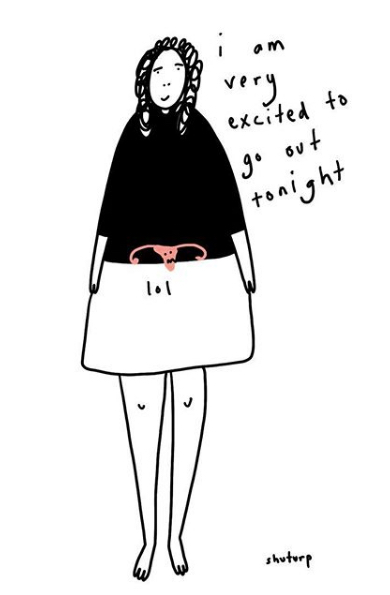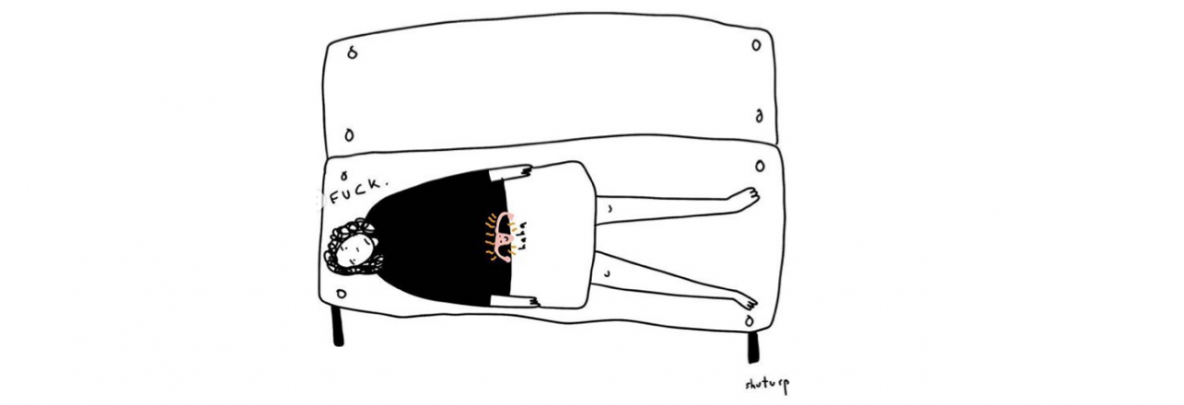Let's End(ometriosis) the stigma
By Eloise Barry

Illustration by @shuturp
Endometriosis is a virtually incurable gynaecological condition causing severe pain and affecting millions of women worldwide.
In sufferers, endometrial tissue from the inner lining of the uterus grows outside of the womb. During periods the womb lining sheds and leaves the body, but the tissue on the outside has nowhere to go. This causes inflammation, adhesions and subsequent scarring, which can cause severe pelvic pain, excruciating sex, and in the worst cases infertility.
Endometriosis can affect all areas of a woman’s life including relationships, work and education. Depression and anxiety are common in sufferers of chronic pain, especially in the knowledge that there is usually no cure. Endometriosis has a financial impact too: Standard Life calculated that sufferers lose on average £5,469 of earnings per year from time off work.
Despite one in ten women of reproductive age suffering with the condition, the average wait time from the initial appearance of symptoms to diagnosis is seven and half years. Indeed, many sufferers experience little to no symptoms, only hearing of the condition far too late, as an explanation to why they fail to conceive.
One of the reasons why such a common illness is so obscure in public knowledge lies in the relative complexity of its diagnosis. Unless it has been left for years and years to grow, endometrial tissue, adhesions or inflammation cannot be spotted on an ultrasound or MRI scan.

Illustration by @shuturp
A keyhole surgical procedure called a laparoscopy, during which a camera is inserted into the abdomen through a small incision, is currently the only way to reach a definitive diagnosis. During the procedure the surgeon can choose to excise, laser, or cauterise the endometrial tissue, which can alleviate symptoms in the short term. Hormone therapy, such as contraception or oestrogen suppressant injections, help slow or prevent regrowth in the long term; however, further laparoscopies are usually necessary.
The cause of the condition remains unknown, which makes it even harder to find a cure. A group of experts at Birmingham University cite lack of funding and research into the disease as the main reason for diminished quality of life for 2 million women in the UK.
Emma Cox, chief of the charity Endometriosis UK, blames a gender bias for the lack of attention given to the disease. Women are taught from puberty that painful periods are normal; thus, sufferers of endometriosis are expected to endure what many doctors mistakenly see as a severe form of period pain.
The figure of seven and a half years for diagnostic time can be partly blamed on GPs who lack knowledge of endometriosis or who confuse symptoms with other conditions. My medical history shows that over ten years I visited the GP on multiple occasions, only to be turned away with the same diagnosis of dysmenorrhea (extremely painful periods) every single time. Not one of them tried to investigate further, and I was only referred to a gynaecologist at my own suggestion when the pain became weekly, keeping me bed-ridden and forcing me to re-sit my university exams.

Cox highlights the importance of the role of GPs in first spotting the disease; “Education, amongst healthcare practitioners, those in education and the public, is the first step to helping drive down diagnosis time.” To mark Endometriosis Awareness Month (March), Endometriosis UK has launched new education material for GPs with the Royal College of GPs to highlight signs, symptoms, and management of the condition.
Increased funding into research and treatments for endometriosis will only be made available with increased awareness. I hope that in the future sufferers will not have to justify their absence from work or university, nor feel the need to hide their pain, both physical and mental, in day-to-day life. Gynaecological conditions should not be taboo.
I want people to have better understanding not just to help sufferers feel understood, but also to help recognise the signs in others so they can receive treatment sooner. The way to empower sufferers of the disease is to listen to their experiences which are so often disregarded by misinformed medical professionals.
Art by
Words by
Share this article

